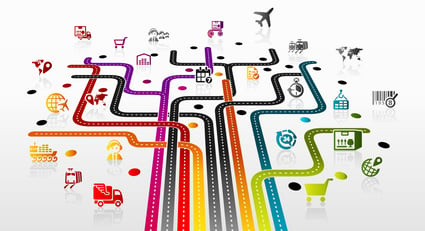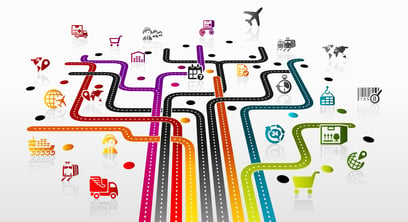How the Industrial IoT Can Add Business Value
Brian Hoey - May 08, 2018

 According to McKinsey’s estimates, the rise of the Internet-of-Things (IoT) will have more than a $11 trillion economic impact within the next 7 years. Much of this value will come in the rapidly evolving world of connected consumer goods, such as the internet-enabled products that make up the modern smart home, but the impact will also be felt widely in a number of industries, from health care to natural gas production to, of course, automotive manufacturing. We’ve spoken briefly on this blog about the application of IoT devices for tracking inventory usage and traffic patterns, but what impact will this explosion of connected devices have on factory production processes themselves? More to the point, how can you leverage them into meaningful value propositions within your business’ existing workflows.
According to McKinsey’s estimates, the rise of the Internet-of-Things (IoT) will have more than a $11 trillion economic impact within the next 7 years. Much of this value will come in the rapidly evolving world of connected consumer goods, such as the internet-enabled products that make up the modern smart home, but the impact will also be felt widely in a number of industries, from health care to natural gas production to, of course, automotive manufacturing. We’ve spoken briefly on this blog about the application of IoT devices for tracking inventory usage and traffic patterns, but what impact will this explosion of connected devices have on factory production processes themselves? More to the point, how can you leverage them into meaningful value propositions within your business’ existing workflows.
IoT vs IIot – What’s the difference?
To begin with, it may be useful to sketch out the differences between general Internet-of-Things and the Industrial IoT (IIoT) in particular, though the difference is more or less intuitive. Where IoT devices can and do come in all shapes and sizes, from light bulbs to toaster ovens, IIoT refers specifically to internet-connected factory machinery and sensors, along with any connected devices that might be integrated into manufacturing workflows. Though a large proportion of manufacturing machinery has long been internet-connected, offering digital interfaces for users to gain information and schedule tasks, IIoT devices offer not just improved interfaces but a new informational paradigm: devices communicate with one another and with a centralized system in a way that makes it possible to gather and integrate large amounts of mission critical data in increasingly accessible ways, to automate newer and more complex processes, and to increase intra-operational visibility and connectivity.
IT/OT Integration
Given these potential increases in connectivity, it’s easy to see the impactful role that the IIoT will play in the rise of Industry 4.0 and the development of so-called “smart factories.” That said, merely obtaining internet-capable devices and installing them on the factory floor isn’t enough to drive the vast value-added workflow changes that Industry 4.0 systems can provide. Rather integrating this new operational-technology (OT) with a given business’ centralized IT solutions is a necessary prerequisite to getting the most out of the IIoT. Just like with Postmodern ERP, these two distinct business infrastructures need to communicate in a way that gives supply chain planners a more holistic, accessible view of their entire value chain.
Though reaching this level of technological integration can be a hurdle for manufacturers, the effects can be transformative. Information and decision-making silos will begin to disappear, and previously disparate points on the planning and production streams will become connected within one large, interoperable workflow. Engineers, marketers, and production planners will be able to share the same data, not just regarding day-to-day business workflows but also dealing with real-time production information. Under these conditions, manufacturers can begin to optimize processes with an eye towards the entire value stream. All of sudden, the effects of proposed process changes become much easier to predict and map throughout the supply chain. Machine and sensor data can finally give the day-to-day realities of production processes a coherent voice in operational planning settings.
Machine Learning and Advanced Analytics
Up to this point, we’ve discussed the IIoT in terms of connectivity and the creation of interoperable, cyber-physical systems. The potential for added business value here is not insignificant:
- Decreased information and planning silos can help to reduce breakdowns and bottlenecks by adding visibility to existing processes.
- Increased real-time information can lead to more effective monitoring of production processes, resulting in fewer disruptions.
- Process automation can free up time for supply chain planners and other personnel, leading to increased productivity and recouped revenue.
But the true value of Industrial Internet-of-Things integration arises from the wealth of data that these connected devices can produce and transmit to a central planning infrastructure. While the sheer volume of information would make it virtually impossible for a human planner to derive actionable insights from sensor data, the rise of machine learning and big data analytics has increasingly made it possible to turn mountains of otherwise unstructured and unhelpful data into powerful improvements in forecasting and prescriptive insights.
Naturally, the added value of more accurate forecasts speaks for itself, but the various possible applications of advanced analytics technology are only just now beginning to reveal themselves. For instance, some businesses are experimenting with using IIoT data to help proactively schedule maintenance downtime. By analyzing the complex interconnections hidden within vast caches of machine data, machine learning technology can identify the warning signs of potential breakdowns and alert planners that the machine needs to be taken offline within a certain time frame. By taking the uncertainty out of maintenance processes, planners can take steps to reduce production disruptions by carefully scheduling any downtime in advance.
Looking further ahead, some businesses are considering the implications of adaptive assembly lines, in which real-time order information is transmitted directly to production plant machinery in order to customize products with little to no lead time. In both this instance and the example above, the added business value of IIoT comes from increases in flexibility, adaptability, and visibility, put to use in ways that would have been virtually impossible in previous decades—and no doubt we’re only just scratching the surface of this technology’s capabilities.
LATEST POSTS
- Understand Circular Economy in The Manufacturing Industry
- How Can Industry 4.0 IT Integration Be Achieved Smoothly?
- The Significance of Order Sequencing in Discrete Manufacturing
- How to improve your Supply Chain Management: The Power of Control Towers
- Optimizing Human Resource Scheduling in Manufacturing: A Technological Approach



